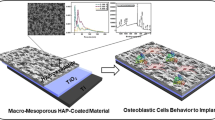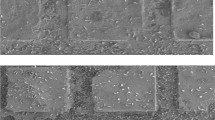Abstract
The nanohybrid structures consisting of hydroxyapatite (HA) and sodium maleate-vinyl acetate copolymer (MP) deposited by Matrix Assisted Pulsed Laser Evaporation (MAPLE) technique on Ti surfaces were investigated for specific biological qualities required in bone implantology. The data from in vitro studies demonstrated that human primary osteoblasts (OBs) firmly adhered to Ti coated with HA–MP as indicated by cytoskeleton and vinculin dynamics. OBs spread onto biomaterial surface and formed groups of cells which during their biosynthetic activity expressed OB phenotype specific markers (collagen and non-collagenous proteins) and underwent controlled proliferation.






Similar content being viewed by others
References
Implantable medical devices and biocompatible materials industry (Review), Business Communications Company, Inc. USA; 2000.
Schmalz G. Concepts in biocompatibility testing of dental restorative materials. Clin Oral Invest. 1998;1:154–62.
Kirkpatrick CJ, Peters K, Hermanns MI, Bittinger F, Krump-Kovalinkova V, Fuchs S, Unger RE. In vitro methodologies to evaluate biocompatibility : status quo and perspective. ITBM-RBM. 2005;26:192–9.
Black J. Biological performance of materials: fundamentals of biocompatibility. USA: CRC Press; 2006.
Kirkpatrick CJ, Mittermayer C. Theoretical and practical aspects of testing potential biomaterials in vitro. J Mater Sci: Mater Med. 1990;1:9–13.
Allen MJ, Rushton N. Use of the CytoTox 96 assay in routine biocompatibility testing in vitro. Promega Notes. 1994;45:7–10.
Jäger M, Fischer J, Schultheis A, Lensing-Höhn S, Krauspe R. Extensive H(+) release by bone substitutes affects biocompatibility in vitro testing. J Biomed Mater Res. 2006;76:310–22.
Van Kooten TG, Klein CL, Kohler H, Kirkpatrick CJ, Williams DF, Eloy R. From cytotoxicity to biocompatibility testing in vitro: cell adhesion molecule expression defines a new set of parameters. J Mater Sci: Mater Med. 1997;8:835–41.
Locci P, Marinucci L, Lilli C, Belcastro S, Staffolani N, Bellocchio S, et al. Biocompatibility of alloys used in orthodontics evaluated by cell culture tests. J Biomed Mater Res. 2000;51:561–8.
Suh H, Park JC, Han D-W, Lee DH, Han CD. A bone replaceable artificial bone substitute: cytotoxicity, cell adhesion, proliferation, and alkaline phosphatase activity. Artif Organs. 2001;25:14–21.
Hailea Y, Haasterta K, Cesnuleviciusa K, Stummeyerb K, Timmera M, Berskic S, et al. Culturing of glial and neuronal cells on polysialic acid. Biomaterials. 2007;28:1163–73.
Ribeiro D, Duarte M, Matsumoto M, Marques M, Salvadori D. Biocompatibility in vitro tests of mineral trioxide aggregate and regular and white portland cements. J Endod. 2005;31:605–7.
Braz MG, Camargo EA, Salvadori DMF, Marques MEA, Ribeiro DA. Evaluation of genetic damage in human peripheral lymphocytes exposed to mineral trioxide aggregate and Portland cements. J Oral Rehabil. 2006;33:234–9.
Shida J, Trindade MC, Goodman SB, Schurman DJ, Smith RL. Induction of interleukin-6 release in human osteoblast-like cells exposed to titanium particles in vitro. Calcif Tissue Int. 2000;67:151–5.
Vahey JW, Simonian PT, Conrad EU. Carcinogenicity and metallic implants. Am J Orthop. 1995;24:319–24.
Trindade MCD, Lind M, Nakashima Y, Sun D, Goodman SB, Schurman DJ, et al. Interleukin-10 inhibits polymethylmethacrylate particle induced interleukin-6 and tumor necrosis factor-alpha release by human monocyte/macrophages in vitro. Biomaterials. 2001;22:2067–73.
Keselowsky BG, Collard DM, Garcia AJ. Integrin binding specificity regulates biomaterial surface chemistry effects on cell differentiation. Proc Natl Acad Sci USA. 2007;102:5953–7.
Jacobs JJ, Gilbert JL, Urban RM. Corrosion of metal orthopaedic implants. J Bone Joint Surg Am. 1998;80:268–82.
Staffolani N, Damiani F, Lilli C, Guerra M, Staffolani NJ, Belcastro S, et al. Ion release from orthodontic appliances. J Dent. 1999;27:449–53.
Le MK, Zhu XM. In vitro corrosion resistance of plasma source ion nitrided austenitic stainless steels. Biomaterials. 2001;22:641–7.
Cui ZD, Chen MF, Zhang LY, Hu RX, Zhu SL, Yang XJ. Improving biocompatibility of NiTi alloy by chemical treatments: an in vitro evaluation in 3T3 human fibroblast cells. Mater Sci Eng C. 2008;28:1117–22.
Ben-Nissan B, Milev A, Vagoc R. Morphology of sol–gel derived nano-coated coralline hydroxyapatite. Biomaterials. 2004;25:4971–5.
Kim H-W, Kim H-E. Nanofiber generation of hydroxyapatite and fluor-hydroxyapatite bioceramics. J Biomed Mater Res B Appl Biomaterials. 2005;77b:323–328.
Wang Y-W, Wu Q, Chen J, Chen G-Q. Evaluation of three-dimensional scaffolds made of blends of hydroxyapatite and poly(3-hydroxybutyrate-co-3-hydroxyhexanoate) for bone reconstruction. Biomaterials. 2005;26:899–904.
Bishop A, Balazsi C, Yang JHC, Gouma P-I. Biopolymer-hydroxyapatite composite coatings prepared by electrospinning. Polym Adv Technol. 2006;17:902–6.
Kumar R, Prakash KH, Cheang P, Gower L, Khor KA. Chitosan-mediated crystallization and assembly of hydroxyapatite nanoparticles into hybrid nanostructured films. J R Soc Interface. 2008;5:427–39.
Pique A. Deposition of polymers and biomaterials using the matrix-assisted pulsed evaporation (Maple) process. In: Eason R, editor. Pulsed laser deposition of thin films. Applications-led growth of functional materials. Hoboken, NJ: Wiley-Interscience; 2007.
Cristescu R, Mihailescu IN, Jelinek M, Chrisey DB. Functionalized thin films and structures obtained by novel laser processing issues. In: Kassing R, Petkov P, Kulisch W and Popov C, editors. Functionalized properties of nanostructured materials, Nato Science Series II: Mathematics, Physics and Chemistry, Vol. 223. Springer, 2006. p. 211.
Frycek R, Jelinek M, Kokourek T, et al. Thin organic layers prepared by MAPLE for gas sensor application. Thin Solid Films. 2006;495:308–11.
Jelinek M, Cristescu R, Mihailescu IN, Chrisey DB, et al. Matrix assisted pulsed laser evaporation of cinnamate-pullulan and tosylate-pullulan polysaccharide derivative thin films for pharmaceutical applications. Appl Surf Sci. 2007;253:7755–60.
Gyorgy E, Axente E, Mihailescu IN, Predoi D, Ciuca S, Neamtu J. Creatinine biomaterial thin films grown by laser techniques. J Mater Sci. 2008;19:1335–9.
Cristescu R, Mihailescu IN, Stamatin I, Doraiswamy A, Narayan RJ, Westwood G, et al. Thin films of polymer mimics of cross-linking mussel adhesive proteins deposited by matrix assisted pulsed laser evaporation. Appl Surf Sci. 2009;255:5496–8.
Klepetsanis KP, Koutsoukos PG, Chitanu GC, Carpov A. Application of water soluble polymers. In: Amjad Z, editors. Acs Symposium Series, New York; 1998. p. 117.
Bouropoulos K, Bouropoulos N, Melekos M, Koutsoukos PG, Chitanu GC, Anghelescu-Dogaru AG, et al. The inhibition of calcium oxalate monohydrate crystal growth by maleic acid copolymers. J Urol. 1998;159:1755–61.
Piticescu RM, Chitanu GC, Popescu ML, Lojkowski W, Opalinska A, Strachowski T. New hydroxyapatite based nanomaterials for potential use in medicine. Ann Transpl. 2004;9:20–5.
Piticescu RM, Chitanu GC, Albulescu M, Giurginca M, Popescu ML, Lojkowski W. Hybrid HAp-maleic anhydride copolymer nanocomposites obtained by in situ functionalisation. Solid State Phenomena. 2005;106:47–56.
Negroiu G, Piticescu RM, Chitanu GC, Mihailescu IN, Zdrentu L, Miroiu M. Biocompatibility evaluation of a novel hydroxyapatite-polymer coating for medical implants (in vitro tests). J Mater Sci. 2008;19:1537–44.
Chitanu GC, Popescu I, Carpov A. Synthesis and characterisation of maleic anhidryde copolimer and their derivatives. Addition polimerization-literature survey. Rev Roum Chim. 2005;50:589–99.
Chitanu GC, Popescu I, Carpov A. Synthesis and characterization of maleic anhydridecopolymers and their derivatives. New data on the copolymerization of maleic anhydride with vinyl acetate. Rev Roum Chim. 2006;51:915–29.
Saunders RM, Holt MR, Jennings L, Sutton DH, Barsukov IL, Bobkov A, et al. Role of vinculin in regulating focal adhesion turnover. J Cell Biol. 2006;85:487–500.
Lim JY, Dreiss AD, Zhiyi Z, Hansen JC, Siedlecki CA, Hengstebeck RW, et al. The regulation of integrin-mediated osteoblast focal adhesion and focal adhesion kinase expression by nanoscale topography. Biomaterials. 2007;28:1787–97.
Scholzen T, Gerde J. The Ki-67 protein: from the known and the unknown. J Cell Physiol. 2000;182:311–22.
Gonzalez-Mcquire R, Chane-Ching J-Y, Vignaud E, Lebugle A, Mann S. Synthesis and characterization of amino acid-functionalized hydroxyapatite nanorods. J Mater Chem. 2004;14:2277–81.
Hennessy KM, Pollot BE, Clem WC, Phipps MC, Sawyer AA, Culpepper BK, et al. The effect of collagen I mimetic peptides on mesenchymal stem cell adhesion and differentiation, and on bone formation at hydroxyapatite surfaces. Biomaterials. 2009;30:1898–909.
Murphy MB, Hartgerink JD, Goepferich A, Mikos AG. Synthesis and in vitro hydroxyapatite binding of peptides conjugated to calcium-binding moieties. Biomacromolecules. 2007;8:2237–43.
Suratwala SJ, Cho SK, Van Raalte JJ, Park SH, Seo SW, Chang SS, et al. Enhancement of periprosthetic bone quality with topical hydroxyapatite-bisphosphonate composite. J Bone Joint Surg Am. 2008;90:2189–96.
Schneiders W, Reinstorf A, Biewener A, Serra A, Grass R, Kinscher M, et al. In vivo effects of modification of hydroxyapatite/collagen composites with and without chondroitin sulphate on bone remodeling in the sheep tibia. J Orthop Res. 2009;27:15–21.
Bianco P, Riminucci M, Gronthos S, Robey PG. Bone marrow stromal stem cells: nature, biology, and potential applications. Stem Cells. 2001;19:180–92.
Buttery LD, Bourne S, Xynos JD, Wood H, Hughes FJ, Hughes SP, et al. Differentiation of osteoblasts and in vitro bone formation from murine embryonic stem cells. Tissue Eng. 2001;7:89–99.
Juliano RL. Signal transduction by cell adhesion receptors and the cytoskeleton: functions of integrins, cadherins, selectins, and immunoglobulin-superfamily members. Ann Rev Pharmacol Toxicol. 2002;49:283–323.
Lampin M, Wararocquier-Clerout R, Legris C, Degrange M, Sigot-Luizard MF. Correlation between substratum roughness and wettability, cell adhesion, and cell migration. J Biomed Mater Res. 1997;36:99–108 .
Anselme K. Osteoblast adhesion on biomaterials. Biomaterials. 2000;21:667–81.
Keselowsky BG, Collard DM, Garcia AJ. Surface chemistry modulates focal adhesion composition and signaling through changes in integrin binding. Biomaterials. 2004;25:5947–54.
Zreiqat H, Valenzuela SM, Nissan BB, Roest R, Knabe C, Randalski RJ, et al. The effect of surface chemistry modification of titanium alloy on signaling pathways in human osteoblasts. Biomaterials. 2005;26:7579–86.
Clark EA, Brugge JS. Integrins and signal transduction pathways: the road taken. Science. 1995;268:233–9.
Acknowledgments
This work was supported by National Program Research for Excellence Grant no. 46/2005-2008. The authors thank to Dr. Roxana Mustata for contribution to the preparation of fluorescence microscopy figures and to Emilia Ardelean for technical assistance.
Author information
Authors and Affiliations
Corresponding author
Rights and permissions
About this article
Cite this article
Sima, L.E., Filimon, A., Piticescu, R.M. et al. Specific biofunctional performances of the hydroxyapatite–sodium maleate copolymer hybrid coating nanostructures evaluated by in vitro studies. J Mater Sci: Mater Med 20, 2305–2316 (2009). https://doi.org/10.1007/s10856-009-3800-7
Received:
Accepted:
Published:
Issue Date:
DOI: https://doi.org/10.1007/s10856-009-3800-7




